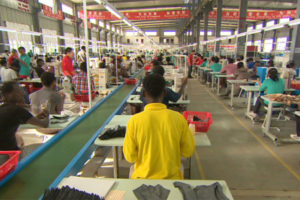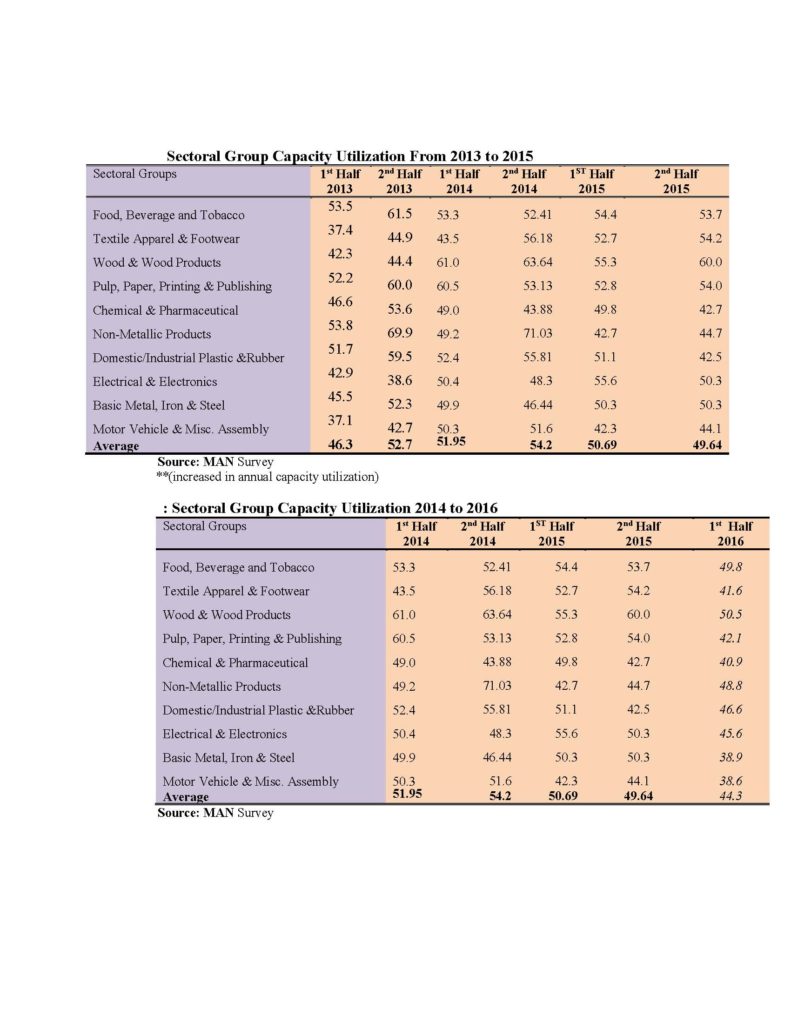The recent alarm by the Chairman, Manufacturers Association of Nigeria (MAN) Apapa Branch, Babatunde Odunayo on the loss of N500 billion incurred by manufacturers as a result of the flexible exchange rate policy of the Central Bank of Nigeria(CBN) has once again brought to the fore the precarious situation faced by manufacturers in the country.
Although the government has for some time been campaigning for the patronage of made in Nigeria products, the enabling environment to produce these products seems lacking or non-existent. This is even as the government has restricted importation through its foreign exchange rate policy.
Lamenting the operational bottlenecks experienced by manufacturers, Odunayo said that Letters of Credit and Form Ms approved to manufacturers at N197/US$ before the introduction of new flexible exchange rate on June 20, are now expected to be redeemed at N320.
“Unfortunately, this unfolding situation poses a great burden on manufacturers since the pricing of the related manufactured goods was made at N197 or N198 to US dollar when it was approved.
“Manufacturers currently face up to N500 billion in exchange difference between the approved Form M and Letter of Credit established rates and the flexible market rate of N320 to a dollar.
“This is a huge loss that manufacturers are expected to bear, whereas the related goods had been mostly sold before the commencement of the new exchange rate system,” Odunayo said.
He said that the exchange rate loss of N500 billion reflected in their accounts and had led to factory closure, unemployment and loss of investments in the sector.According to him, the exchange rate losses will require additional working capital to shore up cash difference between N320 and N197.
“Many of our members are in the middle of factory projects execution, but the viability of such projects is now questionable due to recent forex developments,” he said.
Stressing on the loss experienced by members, he disclosed that if loans were not reversed to pre-flexible exchange rate at which the transactions were contracted, losses to manufacturers would be enormous.He urged the government to remove pre-approved form Ms from the flexible foreign exchange market and deal with it through a structured sovereign loan.
Looking at the overall challenge faced by manufacturers in the last few years and ripple effects in the economy of the country, the alarm by Apapa MAN chairman is a tip of the iceberg. This year alone, manufacturers had had to grapple with myriad of challenges. From investigations, the period between January and June 2016 to the present did not avail much hope for the economy. The rate of inflation has almost doubled, electricity generation has reduced by almost 50percent and the price of petroleum products has also doubled. Foreign exchange earnings have continued to drop significantly due to reduction in output caused primarily by the vandalisation of infrastructure and low crude oil prices in the global market.
While experts acknowledge the effort of the federal government in addressing these issues, they also note that these efforts have not translated into measurable positive indicators but haverather led Nigeria into recession which has created serious worry to private sector operators.
In a half year report recently, National President, Nigerian Association of Chambers of Commerce, Industry, Mines and Agriculture (NACCIMA) Bassey Edem presented the findings of the organisation.
According to the body which champions the course of business through its advocacy role; in the last six months, the situation has not been rosy to manufacturers. He noted that at the beginning of the year, a fixed exchange rate policy of N197 to the US dollar was implemented in the official market from January to June 2016 and the Naira hovered between N300 – N330 to the US dollar in the parallel market. However, with the introduction of the flexible exchange rate policy by the Central Bank of Nigeria in June 2016, the official exchange rate rose to a figure between N280 – N310 to the US dollar with the parallel market rate hovering around N360 – N375 to the US dollar.
For NACCIMA, Inflation rate has almost doubled since the beginning of the year, from 9.55 percent to 16.45 percent, the highest point since 2005.As at October, 2016; it shot up to 18.4 percent in October.
According the Nigerian Bureau of Statistics, the Gross Domestic Growth Rate(GDP) growth rate in the first quarter of 2016 was minus 0.36 percent. In comparison, the GDP growth rate in the fourth quarter of 2015 was 2.11percent while the GDP Growth rate in the first quarter of 2015 was 3.96percent.
At the same time, external reserves, decreased from USD28.02 billion as at February 4, 2016 to USD26.35 billion as at July 21, 2016. Monetary Policy Rate (MPR) was increased to 14percent from 11percent as at February 2016. Interest rate, maintained a double digit figure, with the Prime Lending Rate at 16.13 percent and Maximum Lending Rate of 26.73 percent.
From findings, the Central Bank of Nigeria estimates capacity utilization in the Industrial Sector at 52.7 per cent in the first quarter of 2016, indicating a one percent decrease from the estimated level in the fourth quarter of 2015. The apex bank attributed this development to poor power supply, exchange rate challenges and squeezed cash flow, which impacted on business confidence, hindering activities in the sector.
Since the government acknowledged that the economy is in recession, a situation characterized by negative economic growth in two successive quarters, NACCIMA said that “this situation has been attributed to economic stagnation and increasing inflation,” adding “It is of utmost importance that the economic team of the federal government reviews the monetary and fiscal policies and come up with programmes and activities that would take the country out of the current economic doldrums.” It noted that business operators and Nigerian citizens are patiently looking forward to the “Change” that will bring about the economic turnaround of the country.
Also as regards the decision of the Monetary Policy Committee of the Central Bank of Nigeria to raise the Monetary Policy Rate from 12percent as at 22nd March 2016 to 14percent, as at 27th July 2016, NACCIMA said it acknowledged and understood the decision of the committee as crucial to tackling the rising inflation rate. It also agreed with the committee that most of the factors contributing to the rise in inflation rate which include high cost of electricity, transportation, low industrial activities, and high prices of both domestic and imported food products are outside the direct purview of monetary policy.
“As we lend our voice to the calls by the committee for the urgent diversification of the economy away from oil to manufacturing, agriculture and services, we would like to point out that a call for stakeholders to increase investment in these select sectors of the economy should be followed by lower interest rates in these sectors, as the current rates are too high to stimulate the much needed growth to lift the economy out of its current phase,” it declared.
Looking at other variables affecting manufacturers in the country,SHIPS AND PORTS DAILY investigations reveal that the positive outlook of the energy generated in the early part of the year could not be sustained as power generation has continued to drop in the last five months. This has made access to power frustrating to the business operators. The government attributes this to the vandalisation of gas pipelines which has hampered the supply of gas to the power plants. Industry experts however thinkthat the government should put more effort into alternative and renewable energy sources for power generation to overcome these challenges which serious impede manufacturing.
Analysts also believe that the government should consider decentralizing power transmission. They point out why it is necessary to underline the need for investors in the power sector to ensure that consumers enjoy a satisfactory value on power supplied while efforts are intensified on the distribution of prepaid meters. The recent signing of power purchase agreement by the federal government and 14 solar energy firms is applauded by stakeholdersbut they counsel that that government should ensure the timeline in the agreement is strictly adhered to, so that within the shortest possible period there would be an improvement in power supply all around the country while they continue to work towards achieving the 30,000MW target to meet the needs of every sector of the Nigerian economy.
SHIPS AND PORTS DAILY discovered that the interest rate which has hovered between 17 percent and 28 percent remains unchanged despite continued call by stakeholders for the government to devise strategies that will bring down the interest rate to a single digit, so as to stimulate the real sector of the economy, enhance access to finance by business operators and increase economic activity in the country. The budget process was which was mired by political drama has also had its multiplier effect on manufacturing.
While pointing out the harsh environment for manufacturers, Sulaimon Ibikunle Tella, managing director, International Paints West Africa Plc (IPWA PLC) said that what is happening to the economy and the power sector inclusive is lack of stability in the system. He noted that for the economy to achieve optimum growth there must be stability to enhance sustainability both in the medium term and long-run expectation.
He explained that the greatest challenge, especially for the industrial sector, is power crisis, which is why local manufacturers cannot compete with their foreign counterparts. “For instance, a company can run its plant 16 hours a day on generator. In fact, Nigerians should be able to challenge the electricity distribution companies for poor services. They give us estimated bills instead of pre-paid meters that we ought to use” He cited a case where the company was given an estimated bill of over N600, 000 for the month. “You can imagine that huge amount for a manufacturing firm for one month, even when electricity supply is not stable. Other manufacturers are paying similar electricity bills, yet they spend so much buying diesel on daily basis to power their generators,” he snapped.
The harsh economy has led to the closure of hitherto viable manufacturing firms with most of the relocating neighbouring countries. Stakeholders in the sector have also expressed worries on the continued closure of most of the known firms. They noted that unless the situation is urgently addressed, it may spell doom for the economy.
Technocrat and former managing Director of Neimeth Plc, Mazi Sam Ohuabunwa, said many factors were responsible for the collapse of the manufacturing sector the top which isthe harsh environment. ”The last few years have been very challenging. Many companies have been grappling with the ripple effects of the global financial crisis. The ones that survived contend with effective demand which has shrunk. This problem was exacerbated by the difficulty in getting cheap and long terms loans for financing the real sector,” he lamented.
A former Director General, NACCIMA, John Isemede, said the current environment under which the manufacturing sector operated is very harsh with no basic infrastructure to support industrial development.
Experts have noted that as one of the serious steps towards stopping the trend of total collapse of the industry or extinction, manufacturing entities in Nigeria should be given unqualified 10 years tax holiday covering all taxes, levies, dues or any form of collections by or payable to the federal, state and local governments including non-deduction of taxes on all their direct and indirect human, material, machine or any other items or related transactions that flows into their operations.” This is for the government to decide.
Below is STATISTICS OF SECTORAL CAPACITY UTILIZATION in Nigeria from 2013-2016 as approved by MAN headquarters. It shows the performance of different manufacturing sectors within the period.
Copyright 2016 Ships & Ports Ltd. Permission to use quotations from this article is granted subject to appropriate credit given to www.shipsandports.com.ng as the source.

